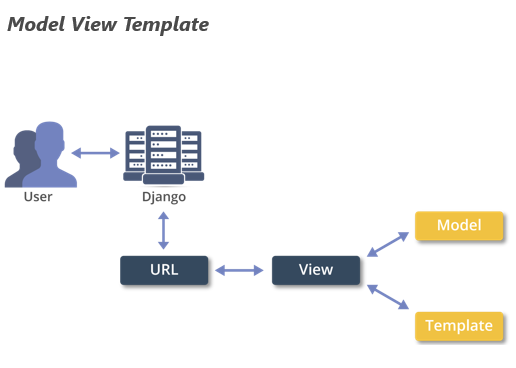Django is an open-source web application framework written in Python. Developed in a fast-paced newsroom, Django enables the rapid development of easily maintainable and secure websites. It’s a favorite of newbies and advanced programmers alike.
Django is the most popular Python web framework around. It makes it easy to build web apps more quickly and with less code. The demand for Django developers remains high as it's the most sought-after skill set right now.
Advantages of using Django:
- Rich Ecosystem: It comes with numerous third-party apps which can be easily integrated as per the requirements of the project.
- Maturity: Django has been in use for over a decade. In the time frame, a lot of features are added and enhanced to make it a Robust framework. Apart from that, there are a large number of developers who are using Django.
- Admin panel: Django provides an admin dashboard that we can use to do basic CRUD operations over the models.
- Plugins: Allow programmers to add various features to applications and leave sufficient space for customization.
- Libraries: Due to the large development community there is an ample number of libraries for every task.
- ORM: It helps us with working with data in a more object-oriented way.
Q1.) What is Django?
Django is a web development framework that was developed in a fast-paced newsroom. It is a free and open-source framework that was named after Django Reinhardt who was a jazz guitarist from the 1930s. Django is maintained by a non-profit organization called the Django Software Foundation. The main goal of Django is to enable Web Development quickly and with ease.
Q2.) Name some companies that make use of Django?
Some of the companies that make use of Django are Instagram, DISCUS, Mozilla Firefox, YouTube, Pinterest, Reddit, etc.
Q3.) What are the features of Django?
- SEO Optimized
- Extremely fast
- Fully loaded framework that comes along with authentications, content administrations, RSS feeds, etc
- Very secure thereby helping developers avoid common security mistakes such as cross-site request forgery (csrf), clickjacking, cross-site scripting, etc
- It is exceptionally scalable which in turn helps meet the heaviest traffic demands
- Immensely versatile which allows you to develop any kind of websites
Q4.) What are the features of Django?
- SEO Optimized
- Extremely fast
- Fully loaded framework that comes along with authentications, content administrations, RSS feeds, etc
- Very secure thereby helping developers avoid common security mistakes such as cross-site request forgery (csrf), clickjacking, cross-site scripting, etc
- It is exceptionally scalable which in turn helps meet the heaviest traffic demands
- Immensely versatile which allows you to develop any kind of websites
Q5.) How do you check for the version of Django installed on your system?
To check for the version of Django installed on your system, you can open the command prompt and enter the following command:
- python -m django –version
You can also try to import Django and use the get_version() method as follows:
import djangoprint(django.get_version())Q6.) Explain Django architecture.
Django follows the MVT or Model View Template architecture whcih is based on the MVC or Model View Controller architecture. The main difference between these two is that Django itself takes care of the controller part.

According to Django, the ‘view’ basically describes the data presented to the user. It does not deal with how the data looks but rather what the data actually is. Views are basically callback functions for the specified URL’s and these callback functions describe which data is presented.
The ‘templates’ on the other hand deal with the presentation of data, thereby, separating the content from its presentation. In Django, views delegate to the templates to present the data.
The ‘controller’ here is Django itself which sends the request to the appropriate view in accordance with the specified URL. This is why Django is referred to as MTV rather than MVC architecture.
Q7.) What are Django’s templates?
Django templates render information in a designer-friendly format to present to the user. Using the Django Template Language (DTL), a user can generate HTML dynamically. Django templates consist of simple text files that can create any text-based format such as XML, CSV, and HTML.
Q8.) Discuss Django’s Request/Response Cycle.
Starting the process off, the Django server receives a request. The server then looks for a matching URL in the URL patterns defined for the project. If the server can’t find a matching URL, it produces a 404-status code. If the URL matches, it executes the corresponding code in the view file associated with the URL and sends a response.
Q9.) Briefly explain Django Field Class.
‘Field’ is basically an abstract class that actually represents a column in the database table. The Field class, is in turn, a subclass of RegisterLookupMixin. In Django, these fields are used to create database tables (db_type()) which are used to map Python types to the database using get_prep_value() and vice versa using from_db_value() method. Therefore, fields are fundamental pieces in different Django APIs such as models and querysets.
Q10.) How to do you create a Django project?
To create a Django project, cd into the directory where you would like to create your project and type the following command:
- django-admin startproject xyz
NOTE: Here, xyz is the name of the project. You can give any name that you desire.



.png)



0 Comments